Blog →
All-hands Team Memo • March 2024

Blog →


by
Philippe Lehoux
March 28, 2024
· Updated on
At Missive, we're not fans of meetings. However, we’ve just started doing all-hands, few times a year, to keep in sync.
The idea is, prior to each, I send a written memo about our vision, challenges, strategies, and roadmap – a snapshot of our current status.
After writing the first one, I decided why not share it with our customers. Here it is, memo numero uno.
👋 Hello team,
Things have changed a lot in the last few months for us at Missive. It's important that we all share a common understanding of our journey, our goals, and the path ahead.
Instead of lengthy all-hands meetings where only I talk, I'll capture our vision, challenges, strategies, and roadmap in writing first so you can participate and ask questions.
I wrote each section of this memo to convey specific insights or updates, designed for clarity and brevity. While some sections are brief, each is important. Feel free to engage with each part as it resonates with your role and interests, but I encourage a thorough read to grasp the full picture of where we stand and where we're headed.
In 2013, Rafael, Etienne, and I started working together on a product called ConferenceBadge, a simple name badge designing tool for event organizers. The product quickly gained traction, allowing us to work full-time on it. However, early on, regardless of sales increasing, we decided that was not what we wanted to do with most of our time.
We wanted to work on a more ambitious project, Missive. The initial idea, devised by Etienne, was: Could we create a collaborative email draft editor? This idea quickly morphed into the first Missive prototype, a full-fledged collaborative email client merged with team chat.
From its inception, Missive was a bold move. By rejecting a safe path for something more ambitious — discarding a successful, revenue-generating, bootstrapped product like ConferenceBadge to work on an unproven idea — many called us crazy.
There, I see two guiding principles, which I think we all should keep and apply forward:
ConferenceBadge was our foundation, it gave us the means and de-risked our path to working on a product normally built by teams massively funded.
For much of Missive's history, we were a small team of three, ruthlessly prioritizing listening to and delighting our customers.
Our process to decide what to work on next was simple: do customer support ourselves and set out to improve some of the bigger pains our customers were experiencing at that moment. This shows on our changelog, a long list of incremental improvements.
This process worked magically at first, we could fix issues at a speed unmatched by our competitors and ship innovative features at a blistering pace.

After 8 years and more than 3500 paid customers, it started to show its limitations. As we've grown, so has our to-do list. Not too long ago, I found myself knee-deep in customer support, with Rafael and Etienne tackling bug reports that seemed to multiply overnight.
The three of us, juggling everything, had become too big of a liability. We didn't have enough time to do anything meaningful.
Working on a project like Missive can be extremely satisfying when you have the space and time to experiment. Lately, we were more and more heads down, just trying to make things work.
After a couple of attempts at scaling the team unsuccessfully, we were exhausted.
Then, on a rainy November day at a microbrewery near the office, we each took turns, Rafael, Etienne, and I, discussing what we wanted and where we wanted to go. What transpired was that we were absolutely not exhausted from working on Missive, but mostly we were exhausted from doing it alone. On that day, we laid down a plan.
Fast forward 5 months later and I believe we are on track. The team has grown, each of you brings something unique to the table, be it from past collaborations, as a customer, or through your work experiences. Your fresh perspectives and skills are exactly what Missive needs to leap forward. With more hands on deck, we're not just looking to distribute the workload; we're aiming to multiply our capabilities.
I’m confident in saying we are extremely talented and we have what it takes to make a big impact.
I personally set a high bar for ourselves, aspiring to be mentioned in the same breath as Notion and Linear; products known not just for their utility but for their innovative edge and the quality of their user experience.
We were a tiny team, now that we are a bit bigger, we are still going to punch far above our weight.
We have the ambition of being a meeting-less culture, that’s even why some of you were interested to apply to a job at Missive. Now to be meeting-less, there's a requirement, we need alignment, we need to agree on where we are going. To that effect I wrote this mission statement:
We are toolmakers. Our tools improve communication by breaking silos and ease collaboration. They are built for teams having an outsized impact on the world, like us.
Toolmakers love their craft. They are obsessed with the end result. They build in service of others. They don’t get lost in convoluted processes. They are always focused on creating the best possible product, in the end it’s the only thing that matters.
With more time to think, one of our goals this year is to redefine what Missive is. Aiming to make it not just a shared inbox app but a platform that helps small and medium-sized businesses plan around all the work that revolves around their communications.
This is how we’ve been using Missive at Missive for years now. But it’s not just us, our hubris, it’s also what our most fanatic users have wanted for years:

Etienne and Arnaud will spearhead this project and work together on UI improvements and improvements around task management.
Let me give you an example, a freight transportation broker using Missive will exchange hundreds of emails a day with businesses wanting to deliver parcels.
From these emails, hundreds of tasks need to be completed by different people. Currently, such a customer might use the basic task functionality in Missive to achieve this, but it's not an ideal experience.
They are most likely to fall back on using a platform like ClickUp or Asana to manage those tasks, alongside Missive. The feedback we've consistently received is clear: such users would prefer a seamless experience within Missive, where task management is integrated directly into the communication flow. The current task's implementation is too simplistic and conversation-centric. Once tasks are created, they are lost in the sea of conversations and there is no accountability possible.
I believe there's a significant market opportunity here, as virtually every business that relies heavily on daily communication via email or any other text communication channels could benefit from such a built-in way to manage tasks around communication.
We need to make this vision a reality on the product side but also to clearly articulate this via our brand and our different marketing initiatives. This will set us apart from traditional help desks.
AI is on everyone’s radar; it’s the new hot thing. To me, it would be a mistake to market ourselves as an AI product or define all of our roadmap around it. Of course, short-term it would be great, free media and a lot of attention. But long term all products will have AI built-in. This won’t be a differentiator at all. There is no moat in AI.
Now, I’m not saying it's not important, it is, what I’m trying to articulate it’s that AI should not be the main part of our DNA. We will experiment with it, we will create buzz with it, it’s just not what will set us apart.
As I wrote before, we were a small team, for a long time. We know we’ve developed ways of working that are not compatible with collaborating with more people. With the help of Louis-Michel, Denys and Greg on the tech side of things, we already started changing some of our practices.

I expect you, the new team members, to teach us, the original three, how to work and collaborate in a bigger team. But I expect us to teach you how to be mighty efficient. This will create tensions, it’s good and expected.
As toolmakers, our goal is to create the best product, not implement the best processes. The processes are only good if they help us achieve the best product.
Growth is the consequence of a great product. There is no shortcut. Any growth initiative should be about putting fuel on an already strong fire.
Historically, growth has been around 2%-6% month over month. We always had a solid stream of new inbound users.

This nice consistent growth, hides a darker reality, for every new users and existing ones who grow with us (seat expansion) we have a lot of users who churn, and usually, after a short period of time.

In this graphic, subscriptions = paid organizations. Above purple is good, orange is bad.
To increase our growth rate we need to work on that orange part and better nurture our inbound users. The recipe is simple:
We need to be more deliberate and eloquent about what Missive is by simplifying the product and the message.
I got curious writing this memo and parsed the data from our changelog and generated a graph showing the number of release elements either tagged as New, Improved or Fixed per quarter over the years.

The trends of both New and Improved features are decreasing faster than the Fixed one. With more and more technical debt and customers to care for, a tiny team can’t forever beat the odds.
We use Missive, more than anything else, even when it’s not the best fit. We stick to it, we live with its weaknesses… then we improve it. This experience is our fuel; it guides us into creating a better product from a first hand experience.
We avoid using too many tools. Having a simple stack has more advantages than using the perfect tool for every job. The cognitive cost of learning and maintaining many platforms is high. Let’s not fall into this trap.
On Feb 28th, we announced a price increase. One goal is to make monthly plans more expensive and attract more customers to the new yearly plans.
The announcement email was sent to all ~6k+ admins and owners of paying organizations. We received 124 replies, with 34% neutral, 40% positive, and 26% negative, but none were hyper-negative. So technically, only 0.25% of users replied negatively, which is not bad.
Most of the replies inquired about the possibility of getting their grandfathered seats rolled up into a yearly subscription with a 20% discount. Originally, it was decided that if you upgraded to a yearly subscription, you would move to the new pricing. We decided it would be fair game not to do so. This change allowed me to reply with the following message, to which most responded extremely positively.

I expect to see a lot of customers switching to the yearly subscription next April and May.
Who are our competitors? Missive being a pretty general email/collaboration solution, there are a lot of them. From Front to Spark, Superhuman and even to Intercom and Slack.
Should we care? No, we should always refrain from being obsessed with one or listen to only people who switched over to Missive from one of them. We are not copy cats chasing a space with a discounted product.
A lot of our users come from Front, just search for Front on this page to see. Because of this there are strong demands for us to implement their exact feature set. We sometimes do but most of the time we don’t.
We need to find our way.
――――
The end. That's it, this is the starting point, what are we going to achieve together? See you all, tomorrow, at the 🙌 all-hands!
Philippe Lehoux


January 5, 2026
What we released in 2025
Looking back at 2025, we doubled the size of our team and set out to tackle some of the most requested features from our users.
Each year gives us 365 days to make Missive better for you, our users. I'm excited for 2026 and I'm incredibly proud of what we accomplished in the last 365 days.
Looking back at 2025, we doubled the size of our team and set out to tackle some of the most requested features from our users. We also shipped a handful of improvements that quietly make everyone’s day‑to‑day work in Missive smoother.
Here are some highlights from our favorite releases this year.
This year we introduced AI-powered rules that let automations understand message content rather than rely on static conditions. We expanded them with multi-channel support, model selection, and practical actions like AI labeling, draft creation, and pre-send checks for outgoing messages, making rules more useful in day-to-day workflows.
Rules also became easier to manage with drag-and-drop editing, support for signatures in rule-generated drafts, and the ability to remove users from conversations automatically.
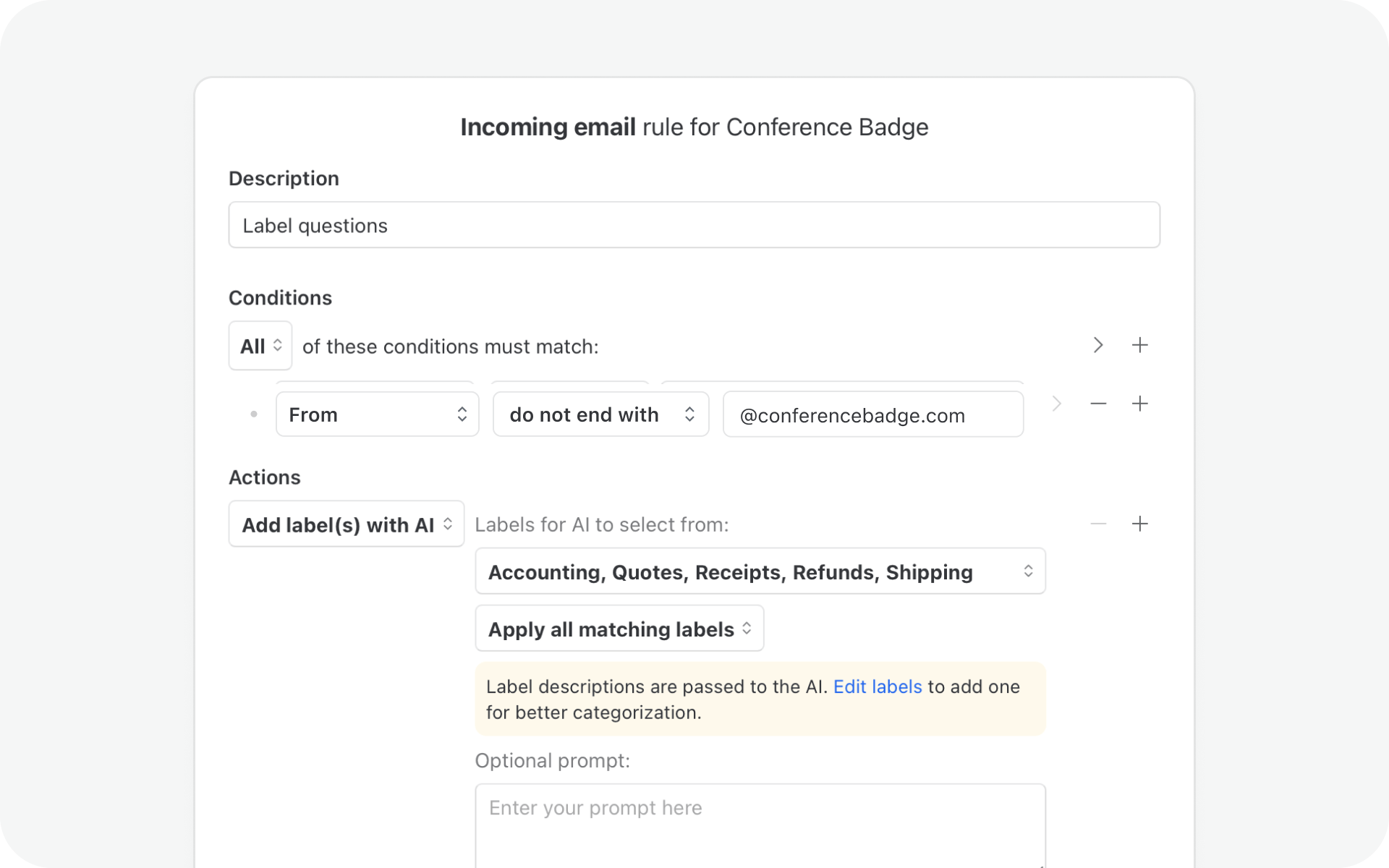
We’ve completely re-imagined how tasks work in Missive. You’ll now find dedicated views that brings together all your tasks into one place.
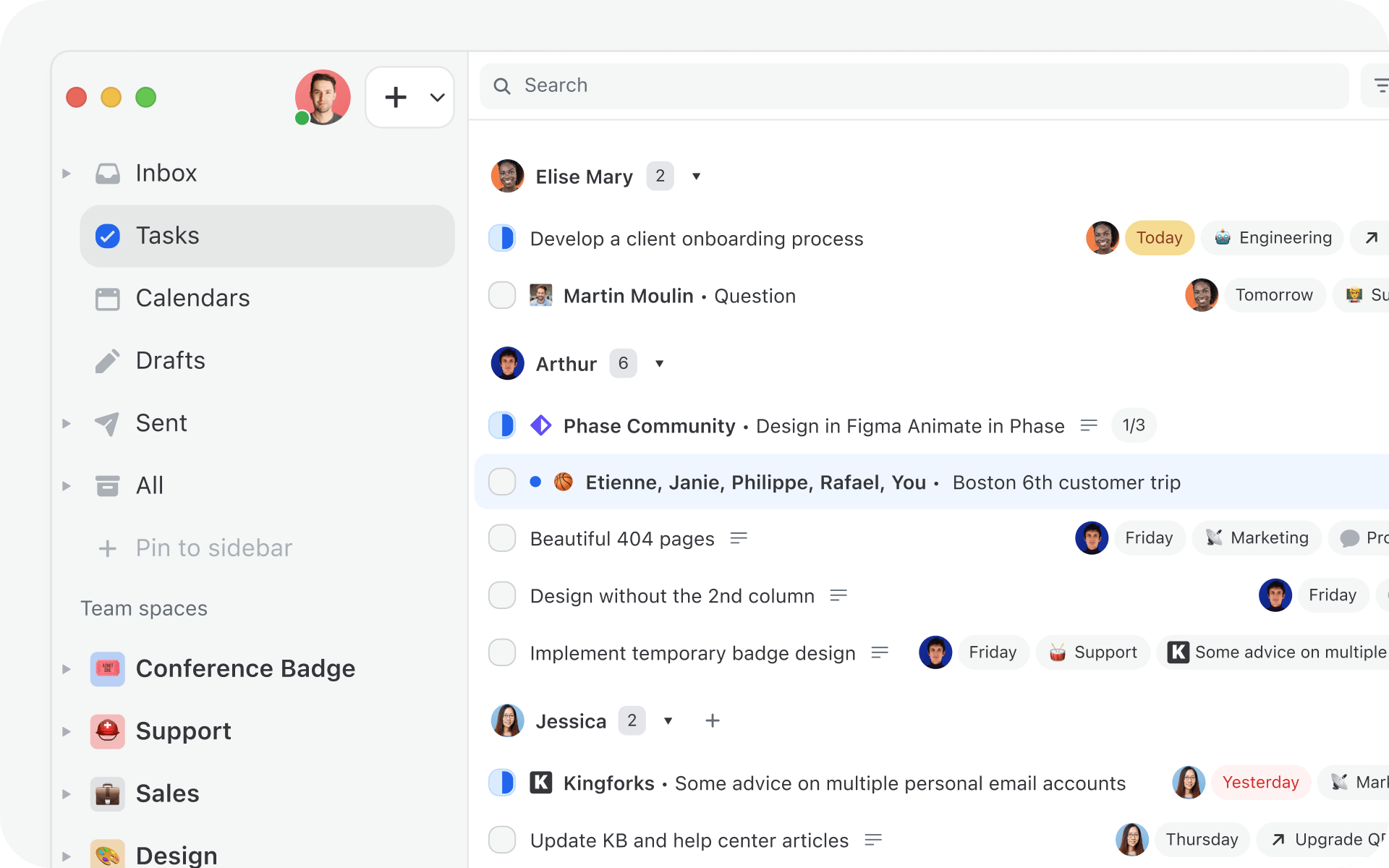
We added search and filter options to make it easier and more efficient to find the information you need. Filters with a specific date range, domain names, only conversations with attachments, etc.

See all files and attachments from any conversation in one unified view. Cleaner thumbnails, category-based organization, and Quick Look with keyboard shortcuts make everyday tasks faster.

Taking a well-deserved break? You can now set up automatic replies for your personal accounts right from your out of office status, no need for a rule.
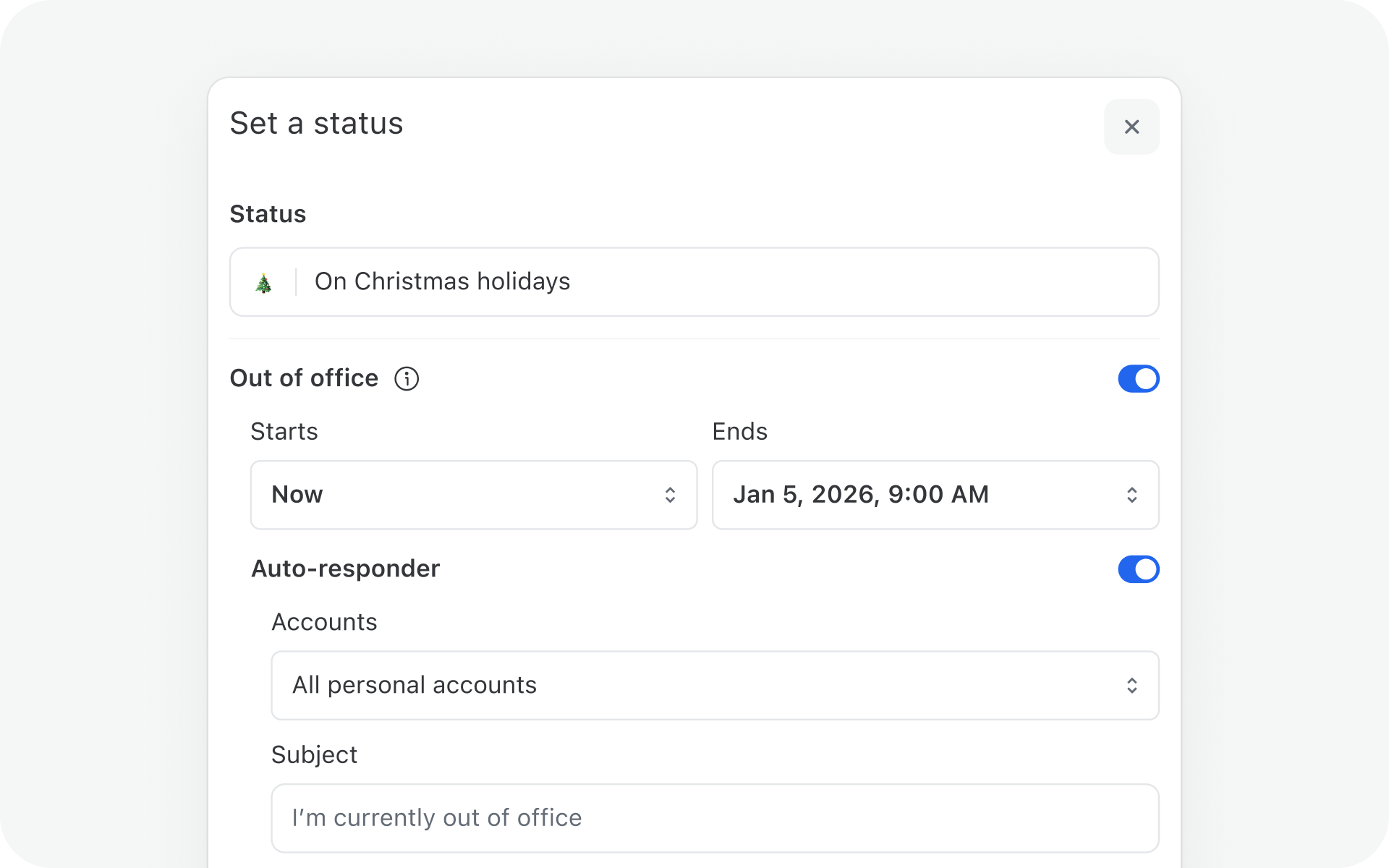
No more forwarding long threads or stitching together feedback from different tools. Guest Access lets you bring people outside your organization, like an accountant, contractor, or client—directly into specific Missive conversations.
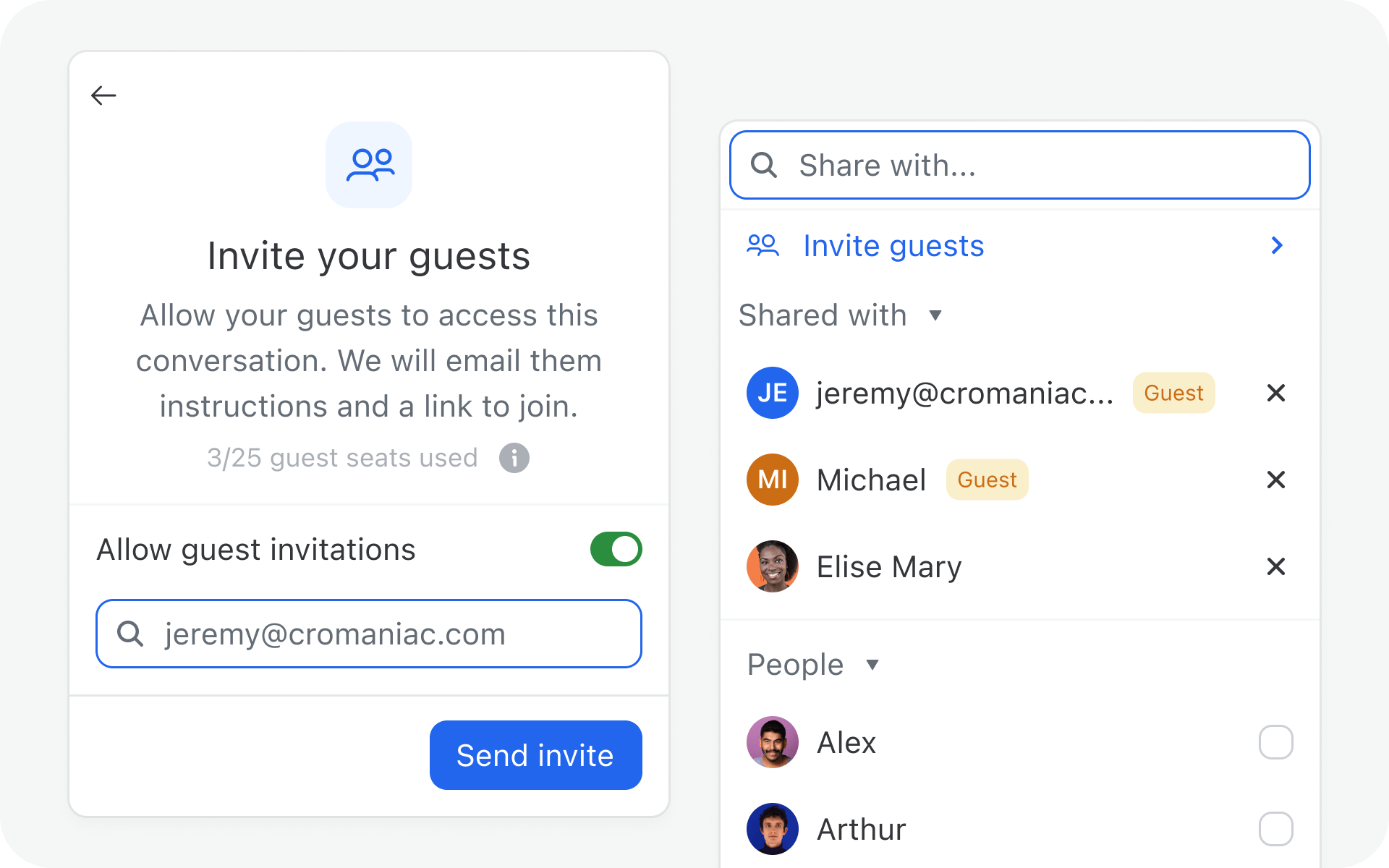
You can now toggle your Drafts and Sent mailboxes to show only the conversations with messages you personally created or all the ones from your colleagues, making it easier to focus on your own work.

We redesigned our signup and onboarding flow to better guide new organizations through their first steps, with clearer hand-holding around creating a team and connecting a first shared account.
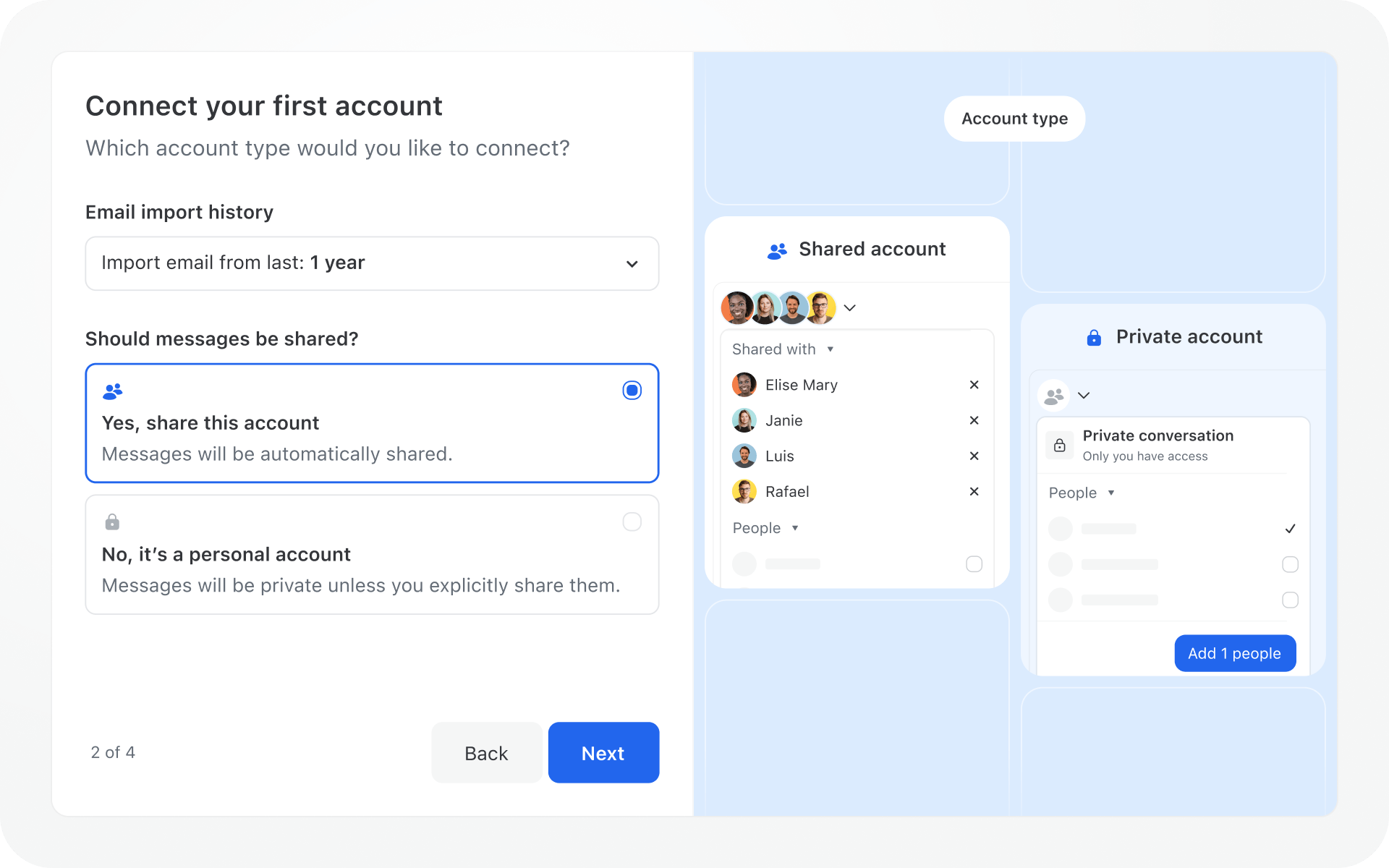
A new way to organize your teams. Every team has now a dedicated space in the sidebar, and every member will see the right elements depending on their role in the team. Quickly access your team’s inbox, Tasks, and Chatroom from the same place.
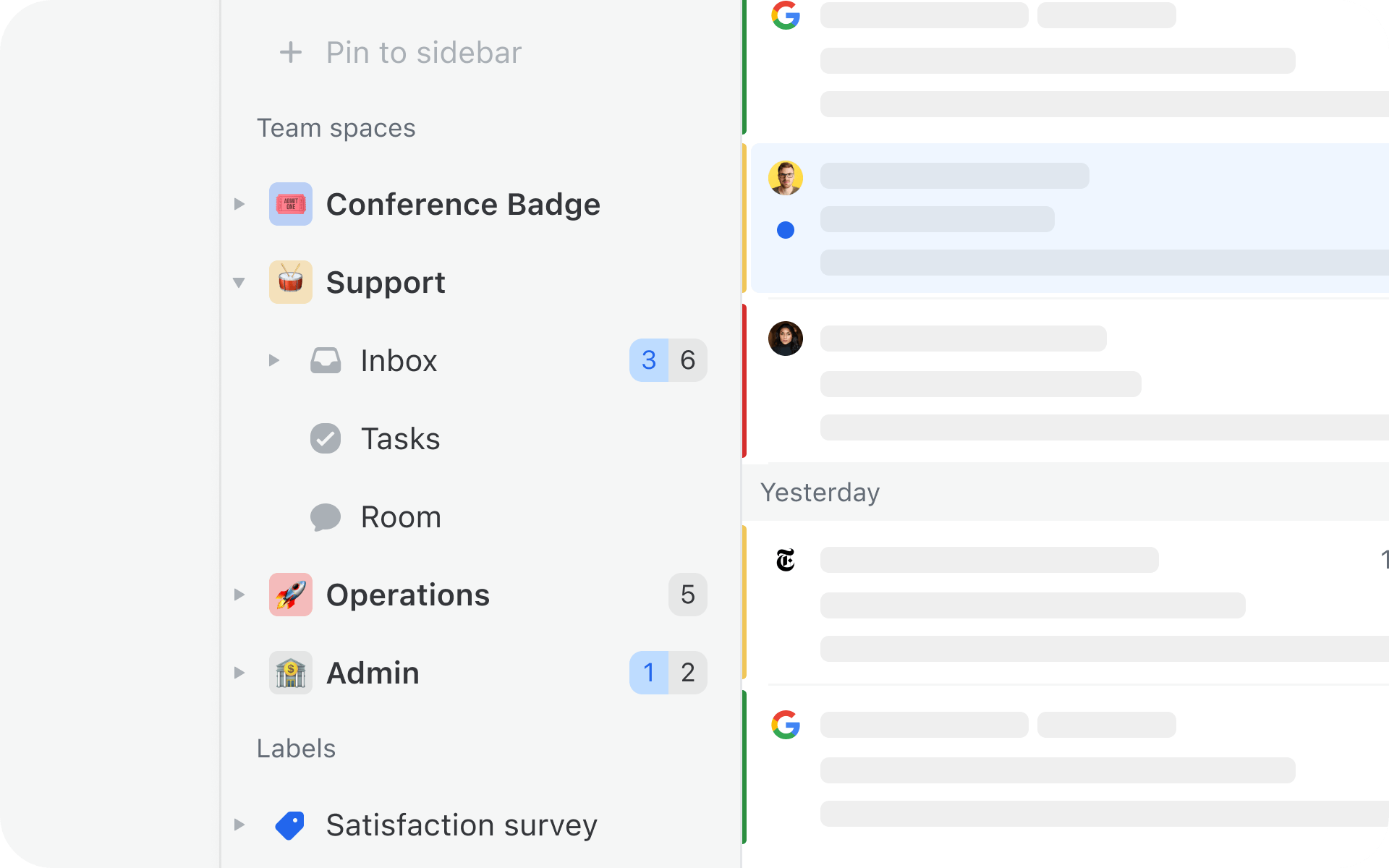
Native support for WhatsApp Business. No need to add a WhatsApp account via a third-party provider anymore, import directly from Facebook Business Manager.
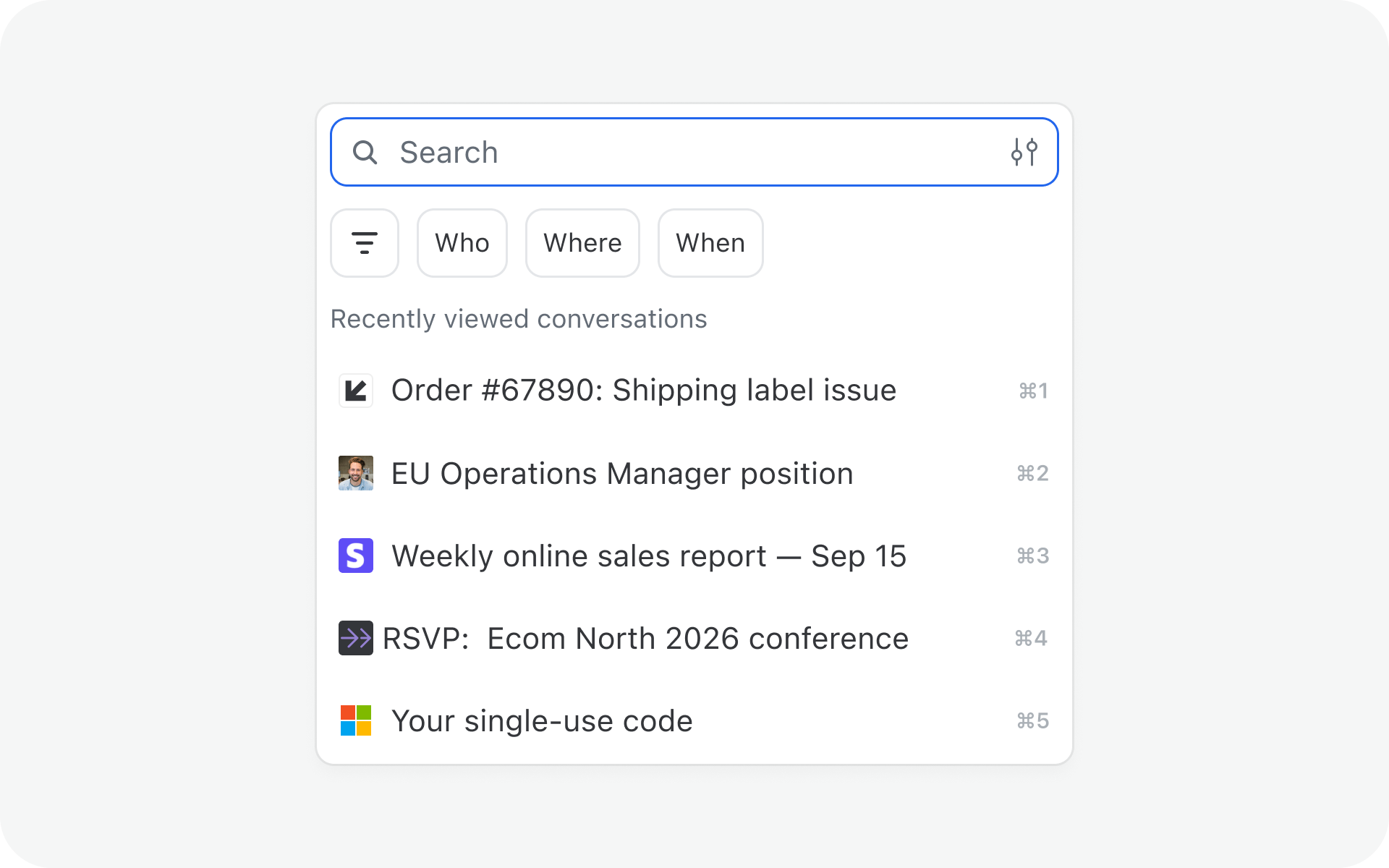
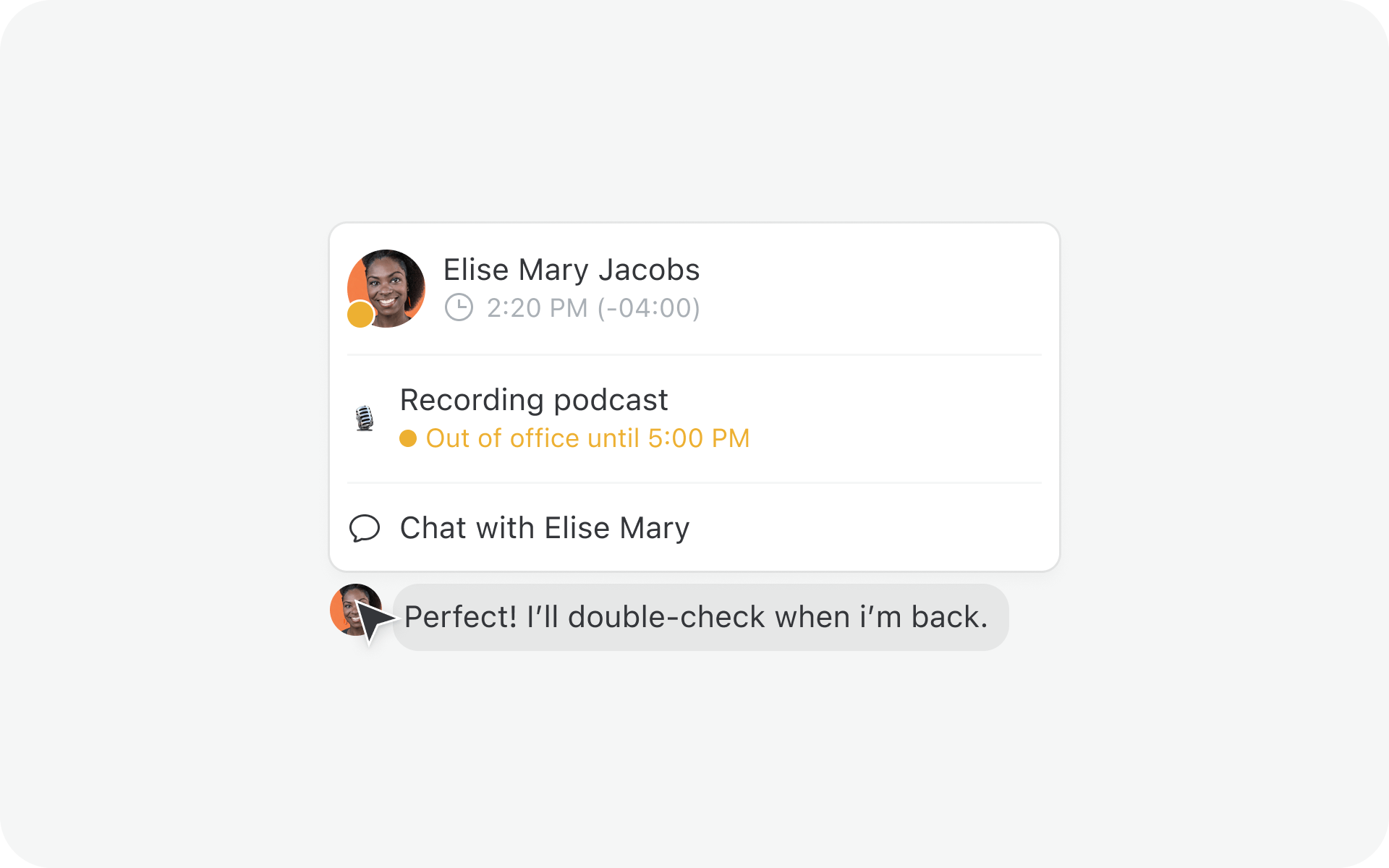
As always, we'll be regularly shipping improvements and posting them on our changelog. We can't wait to show you what we're cooking up in 2026 already.

October 1, 2024
A Decade of Lazy Marketing
A look back at the marketing efforts that fueled Missive's growth over the past 10 years.
When talking about Missive, I often dropped this bomb:
— We never did any marketing.
Well, looking back, it’s a lie. Or let’s just say that it’s an understatement.
Or maybe I was being lazy and not recollecting the many small things we did.
Now that the Missive team is growing fast (read more), I realized, you must tell your team the complete story to equip them with success.
I’m writing this for our future Head of marketing. It’s a list of all of the things we did marketing-wise for the last ten-ish years. As you can see, not so much.
To me it's a testament that, yes, if you build something that people like, they will find you.
Now, imagine with a marketing team...
Note: We got our first customer on Jul. 20, 2016 and we are now at ~$500k USD MRR eight years later.

1. First homepage, at this point Missive was free to use beta. 2015

2. We have a Blog we updated sporadically. 2015 - 2024
3. Multiple ProductHunt launches. 2015-2023

4. A Brief History of Email Apps. - A failed attempt at creating valuable content. Was fun to do, but was a miserable failure. 2015

5. Twitter - Hello Word 2015

6. Email cold outreach to a few people we admired to get feedback and validate the product. No more than 50 emails total were sent. 2015

7. Second homepage and the release of our paid plans. 2016

8. Twitter - I monitored conversations about competitors, email clients, etc. and mentioned Missive in replies. 2016-2023

9. Nailed basic SEO vitals. 2016-2024

10. Open sourced EmojiMart component, now used by big startups (e.g. Figma!). It's a big driver of traffic and backlinks. 2016-2024

11. Attending the Inbox Awesome conference in NYC, the conference was for email marketers, not our target audience. Here is a picture of me on a panel about how to make people open and read your email newsletters. I had 0 clue what I was doing. I attended two years in a row because we like the title "Inbox Awesome" 🤣. 2016-2017

12. Getting both our desktop and mobile javascript apps featured on the App Store and writing about it. This established us as a legitimate player in the email client space. 2017

13. Published VS competitor landing pages, to this day, these are our most valuable content. 2016-2024

14. Developed integrations with popular SaaS (Asana, Salesforce, Aircall, etc.). This created nice co-marketing opportunities like being featured in their app/integration store. 2019-2023

15. Third homepage (current one). 2020

16. We deprecated a really popular feature, read tracking, we explained our reasoning in a blog post. This was an important decision, it helped defined our company culture and product direction. It mostly created churn for solo-user customers.
17. We hired consultants to do SEO + write content. We did with two firms, both times the firm owners were paid Missive users. In both instances we paid $10k/month and the experiment went on for around six months. Six months is not a lot in the SEO world, but each time, both we and the consultant learned that writing good content on an app like Missive is really hard and can't be done by pay-to-hire-content-writers. 2022 & 2024
18. We ditched Google analytics, for privacy reasons, read more. I'm still not so sure about this one, it does feel like we did some privacy-posturing. Now, this might be a potential friction for our future marketing team. We have no plan to re-visit this at the moment.
19. We created a homemade affiliate program. 2022 - 2024

20. MRR milestone blog posts + Hacker news traffic 2021-2024


21. We created many case studies to showcase how Missive is used by people in different industries. Those were pushed on LinkedIn and X.2020-2023

22. We sent a total of forty newsletters, all were a summary of our progress pushing out the content of our changelog. 2016-2024

23. We offer weekly webinars potential customers can attend to learn more about the product and each webinar offers a dedicated Q&A at the end. Those webinars have been a great success, specially for people coming from other competitors looking for a validation that the switch to Missive is a good decision. 2020 - 2024

24. We attended our first trade show in an industry where we find some of our bigger customers, logistic companies. I wrote an article about our experience. 2024

25. We got serious with G2 and other review sites and started earning multiple customer reviews and earning multiple badges. 2024

26. All co-founders did couple of podcasts & interviews over the years. (1, 2, 3, 4, 5, 6, 7, 8, ...) 2016 - 2024
27. I developed our product metric pipeline with Segment and Mixpanel. This will be useful for the future marketing team. 2024

This list is really a testament of how small our team was and how focused on the product we were. We were lucky enough those small initiatives created enough traction to where we are today. Having said that, reading it again, it shows unequivocally how amateurish our marketing efforts were.
It's time to bring expertise and structure, our marketing efforts should be as good as the quality of our product. And thus, we are looking for a Head of Marketing. If you are interested, please reach out (email).